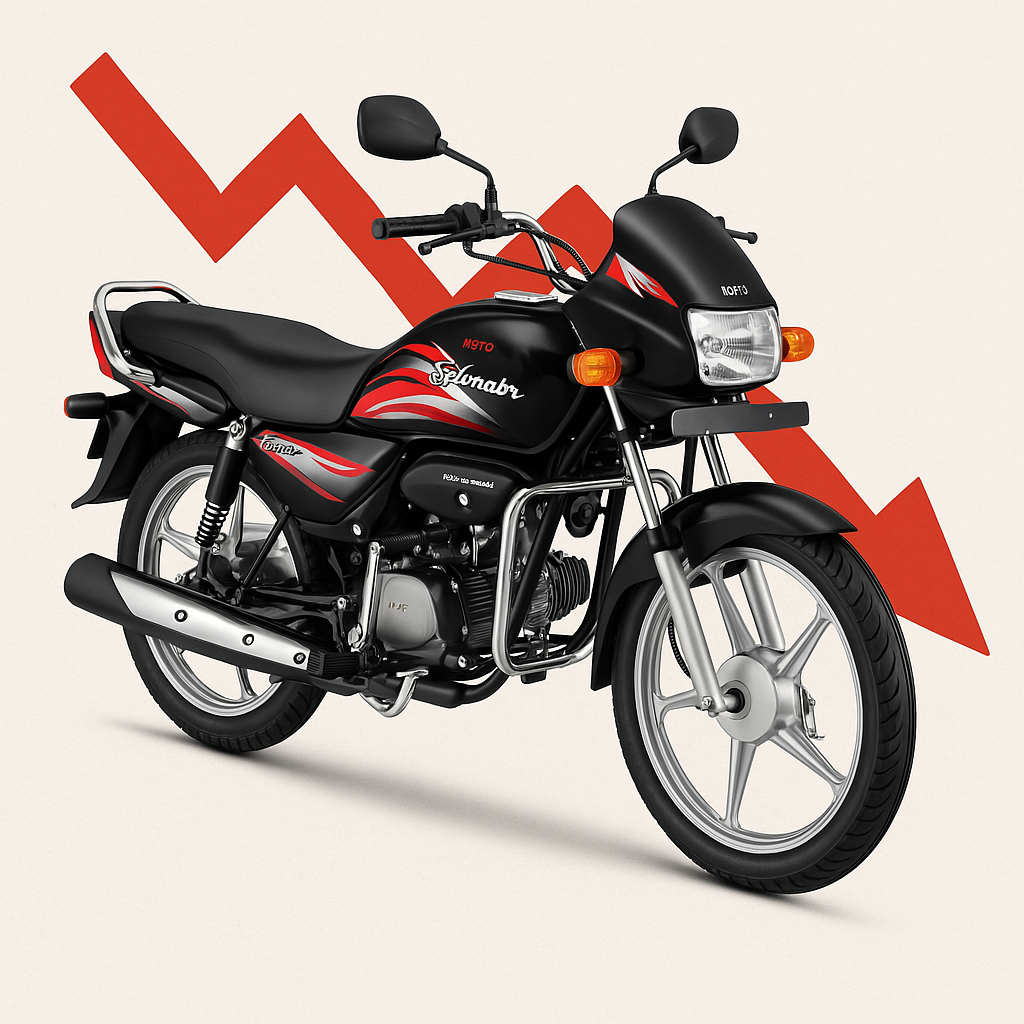
Hero MotoCorp, once celebrated as the heartbeat of India’s two-wheeler market, now finds itself navigating one of the most challenging periods in its history. Known in its earlier days as Hero Honda, the company was a household name, especially in rural India, thanks to its reliable and fuel-efficient motorcycles like the Splendor and Passion. However, the current headlines tell a different story, as the company faces a troubling series of high-profile exits from its senior management. Within a matter of days, six top executives, including CEO Niranjan Gupta, stepped down, raising concerns about the internal health of the company.
This turbulence comes amid weakening financial performance. The company’s stock has fallen nearly 40% from its all-time high, and its February 2025 sales numbers show a sharp 20% decline compared to the same month the previous year. Excluding scooter sales, the slump is even more pronounced. Once unbeatable in the Indian two-wheeler market, Hero MotoCorp is struggling to maintain its footing.
Hero MotoCorp's performance in the fourth quarter of FY25 (January to March 2025) showcased significant growth across various segments, reinforcing its position in the two-wheeler market.
March 2025 Two-Wheeler Sales – YoY Comparison Chart
| Manufacturer | March 2025 Sales | March 2024 Sales | YoY Growth % |
|---|---|---|---|
| Hero MotoCorp | 5,49,604 units | 4,90,415 units | +12% |
| Honda Motorcycle & Scooter India (HMSI) | 4,27,448 units | 3,86,455 units | +10.61% |
| TVS Motor Company | 4,00,120 units | 3,44,446 units | +16% |
| Bajaj Auto | 3,15,732 units | 3,12,828 units | +1% |
| Royal Enfield | 1,01,021 units | 75,936 units | +34% |
In March 2025, the company reported a 12% year-on-year increase in total sales, reaching 549,604 units, up from 490,415 units in March 2024. Domestic dispatches grew by 11% to 510,086 units, while exports rose to 39,518 units, marking a substantial 27% increase compared to the same period last year
For the entire fiscal year FY25, Hero MotoCorp achieved total sales of 5,899,187 units, reflecting a 5% growth over the previous fiscal year's 5,621,455 units. The company's electric vehicle segment, under the VIDA brand, recorded its highest-ever sales, with over 58,000 units sold, representing a remarkable 200% increase over FY24. In March 2025 alone, VIDA V2 electric scooters saw strong demand, with 7,787 units dispatched to customers .
Internationally, Hero MotoCorp expanded its global footprint by exporting 287,429 units in FY25, a 43% growth over the previous fiscal year. March 2025 marked the company's highest-ever monthly exports, with 39,518 units dispatched, a 27% increase compared to March 2024 .
In the premium motorcycle segment, the company continued its strong presence by selling over 11,000 units of the Harley-Davidson X440 in FY25. To enhance customer experience, Hero MotoCorp expanded its Premia dealership network, establishing over 80 outlets across India, offering dedicated sections for Hero, VIDA, and Harley-Davidson products .
These figures indicate a robust performance by Hero MotoCorp in Q4 FY25, with notable growth in domestic sales, exports, and the electric vehicle segment, despite the challenges faced in the earlier parts of the fiscal year.
The roots of Hero’s journey lie in the hardships faced by the Munjal family, who migrated from Pakistan to Ludhiana after India’s Partition. Starting from scratch, they worked humble jobs before launching a small business making bicycle parts. By 1960, Brijmohan Lall Munjal made the pivotal decision to start manufacturing bicycles under the Hero brand. The business flourished, and by 1986, Hero Cycles had earned the title of the world’s largest bicycle manufacturer.
In 1984, the Munjal family entered a groundbreaking joint venture with Japanese auto giant Honda, birthing Hero Honda. This partnership revolutionized India’s two-wheeler landscape by combining Hero’s distribution strength with Honda’s reliable and fuel-efficient technology. The collaboration produced iconic models that became household favorites, especially in smaller towns and villages, where motorcycles were valued for their practicality and longevity. By 2001, Hero Honda had become the world’s largest two-wheeler manufacturer, with bikes like Splendor and Passion dominating Indian roads.
However, in 2010-11, cracks began to appear in the Hero-Honda partnership. Hero wanted to expand globally and strengthen its R&D capabilities, ambitions that Honda, already a global player, wasn’t keen to support. As differences widened, the two parted ways. Hero bought out Honda’s 26% stake and rebranded itself as Hero MotoCorp, turning a once-powerful alliance into a rivalry.
Hero’s motorcycles, particularly the Splendor, had long been its crown jewel. Launched in 1994, the Splendor became an icon for its incredible mileage and dependability. Its rugged suspension and fuel efficiency made it the go-to choice for rural India, where roads were unpredictable, and budgets were tight. Even as of January 2025, Hero sold over 2,45,000 Splendor units, proving the bike’s lasting popularity.
But as the industry began to shift toward premium bikes and electric two-wheelers, Hero struggled to evolve. While rivals like TVS, Bajaj, and even former partner Honda diversified into scooters, performance bikes, and electric vehicles, Hero largely stuck to its old formula. Recently, the company tried to correct course by launching its electric scooter brand, Vida, and expanding its presence into global markets such as Spain, France, and the UK. With eight manufacturing plants — six in India, one in Colombia, and one in Bangladesh — the company has laid the groundwork for international growth, but the domestic picture remains worrisome.
The company’s leadership challenges are equally concerning. Much of the recent instability stems from issues surrounding Chairman Pawan Munjal, who has expanded Hero’s reach to 48 countries and led its foray into the electric vehicle space. However, since August 2023, Munjal has been entangled in legal investigations, including an Enforcement Directorate raid on his home. The situation intensified after a town hall meeting where he addressed the company’s dwindling market share, weak product launches, and rising competition, warning staff of tough measures against underperformance. But the damage had already begun — key resignations, including that of the CEO, and multiple senior leaders followed suit, deepening the company’s internal crisis.
While Hero struggles, its competitors are gaining ground. TVS, for example, posted a 10% year-on-year growth in February 2025, selling 400,000 units, while Hero’s sales slumped 17%. Honda topped the chart with 422,000 units sold that same month. TVS also outpaced Hero in exports, posting a 26% growth rate, and in the electric segment, TVS reported 34% growth, whereas Hero’s Vida sold just 165 units in January 2025.
Hero’s market share decline tells the broader story. From a towering 45% in 2013, the figure has eroded to 26% in 2025. One of the main reasons is the company’s over-reliance on its traditional 100-115cc segment, which once dominated the Indian landscape. With rising incomes and aspirations, customers now favor 125cc and above, where rivals have stronger offerings. Additionally, the electric vehicle market has not been easy for Hero, partly due to a family agreement that restricts it from using the Hero name for EVs. The electric brand Vida lacks the recognition of the Hero name, leaving the company at a branding disadvantage.
For Hero MotoCorp, the road to recovery is far from straightforward. With legacy competitors like TVS and Honda, along with new-age disruptors like Ola Electric, pressing hard on the accelerator, Hero must not only innovate but also rebuild trust and confidence in both its products and leadership. The company that once symbolized reliability and pride for millions of Indian families now faces the critical task of reinventing itself for the future.




